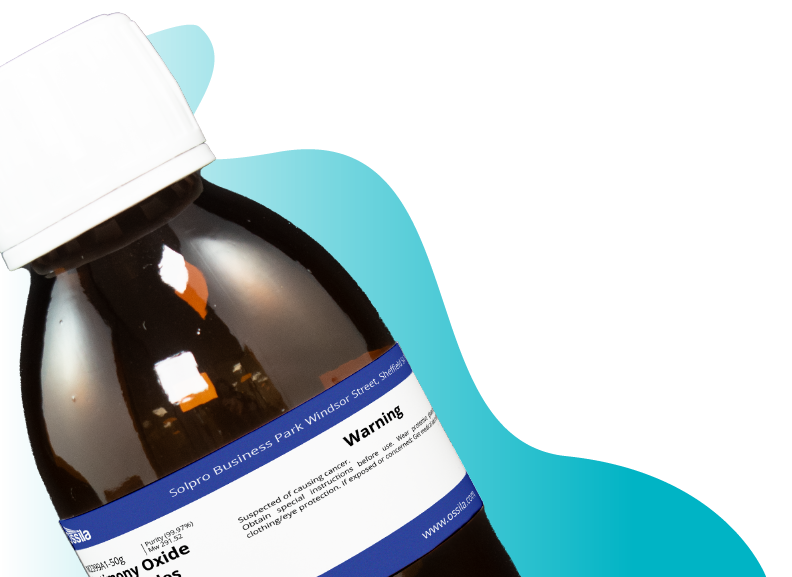Molybdenum Disulfide Few-Layer Film
CAS Number 1317-33-5
2D Materials, Low Dimensional Materials, Materials, Molybdenum Disulfide (MoS2), Transition Metal Chalcogenides (TMCs), Transition Metal Dichalcogenides (TMDs)MoS2 Few-Layer Film, high purity 2D material
For applications in nanoelectronics, optoelectronics, and flexible devices
Technical Data | MSDS | Applications | Literature and Reviews | Related Products | Resources and Support
Few-layer molybdenum disulfide (MoS2), CAS number 1317-33-5, is considered to be one of the most attractive materials for next-generation nanoelectronics. This is due to its silicon-level charge mobility and high current on/off ratio in thin-film transistors. Compared to monolayer MoS2 (which needs a deposition of an additional high-k dielectric layer such as HfO2), few-layer MoS2 can be operated on its own. This makes it more appealing for fabricating transistors and other optoelectronic devices.
High Purity
>99% Purity Molybdenum Disulfide Few-Layer Film
Worldwide shipping
Quick and reliable shipping
Low Cost
Low Cost Molybdenum Disulfide
Applications
Applications in nanoelectronics, optoelectronics, and flexible devices
Technical Data
| CAS Number | 1317-33-5 |
| Chemical Formula | MoS2 |
| Molecular Weight | 160.07 g/mol |
| Bandgap | 1.23 eV |
| Synonyms | Molybdenum sulfide, Molybdenum disulfide, Molybdenum(IV) sulfide |
| Classification / Family | Transition metal dichalcogenides (TMDCs), 2D semiconductor materials, Nano-electronics, Nano-photonics, Materials science |
Product Details
| Substrate | SiO2/Si | Sapphire |
| Product Code | M2167F11 | M2168F11 |
| Size | 1 cm × 1 cm* | 1 cm × 1 cm* |
| Growth Method | CVD synthesis | CVD synthesis |
| Appearance | Transparent | Transparent |
| Purity | >99% | >99% |
| Transparency | >97% | >97% |
| Coverage | >95% | >95% |
| Number of Layers | 2 - 5 | 2 - 5 |
| Sheet Resistance | N/A | N/A |
| Transfer Method | Directly grown | Directly grown |
| Substrate Thickness | 300 nm (oxide layer) | 300 µm |
*Other sizes available: up to 2 cm × 2 cm or 2 inches in diameter (sapphire substrate only).
High-quality molybdenum disulfide (MoS2) few-layer films are available on two different substrates as standard: SiO2/Si and Sapphire. Different substrates of few-layer MoS2 films, including Glass, Silicon and Quartz are also available via custom order.
Please contact us for more information regarding custom products.
Pricing Table
| Substrate | Product code | Size | Quantity (EA) | Price |
|---|---|---|---|---|
| SiO2/Si | M2167F11 | 1 cm × 1 cm | 1 | £420 |
| Sapphire | M2168F11 | 1 cm × 1 cm | 1 | £420 |
MSDS Documents
Molybdenum disulfide monolayer film on silicon
Molybdenum disulfide monolayer film on sapphire
Applications
Molybdenum disulfide (MoS2) few-layer film, with an impressive direct band gap of 1.9 eV in the monolayer regime, has promising potential applications in nanoelectronics, optoelectronics, and flexible devices.
MoS2 few-layer films can also be made into heterostructures for energy conversation and storage devices, and used as a catalyst for hydrogen revolution reactions (HER).
Synthesis
High quality molybdenum disulfide (MoS2) few-layer films were grown directly on the substrates (SiO2/Si and Sapphire) by chemical vapor deposition (CVD) method. The films were later transferred to the desired substrates using wet chemical transfer process.
Usage
MoS2 few-layer film can be used in research purposes such as microscopic analysis, photoluminescence and Raman spectroscopy studies. Few-layer MoS2 film can also be transferred to other substrates.
Literature and Reviews
- Tunable Charge-Trap Memory Based on Few-Layer MoS2, E. Zhang et al., ACS Nano, 9 (1), 612–619 (2015); DIO: 10.1021/nn5059419.
- Few-Layer MoS2: A Promising Layered Semiconductor, R. Ganatra et al., ACS Nano, 8 (5), 4074–4099 (2014); DOI: 10.1021/nn405938z.
- Few-Layer MoS2 with High Broadband Photogain and Fast Optical Switching for Use in Harsh Environments, D. Tsai et al., ACS Nano, 7 (5), 3905–3911 (2013); DOI: 10.1021/nn305301b.
Related Products
We stock a wide range of 2D materials available to purchase online. Please contact us if you cannot find what you are looking for.



